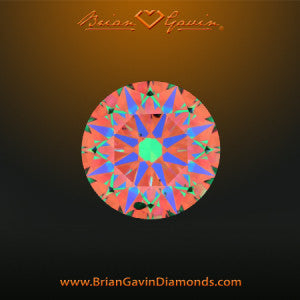
Use 2014 Tax Refund to Buy Diamond Engagement Ring
“I’m expecting a tax refund for 2014 in the range of $6,500 – 7K and thought that I could use my 2014 tax refund to buy a diamond engagement ring; I realize that it might not sound very romantic, but it does provide me with a nice chunk of change! My girlfriend likes cathedral settings, so I’ve decided upon the Melissa cathedral setting from Brian Gavin in 18k white gold, and perhaps this 0.910 carat, G-color, SI-2 clarity, Brian Gavin Signature round diamond; but I’m a bit concerned about the black spot that is visible just to the left of the arrow in the six o’clock position; what is that?”
 Challenges involved with photographing diamonds:
Challenges involved with photographing diamonds:
The black spot that appears just to the left of the six o’clock position in the ASET image that we provided for the 0.910 carat, G-color, SI-2 clarity, Brian Gavin Signature round diamond, is the diamond crystal that is indicated in the relative nine o’clock region on the upper plotting diagram of the diamond that is provided on the Diamond Quality Document (DQD) issued by the American Gem Society Laboratory (AGSL) to help people identify the inclusions that were present within the diamond at the time it was submitted for grading. It is common for inclusions to show up black in diamond grading photographs.
Diamond inclusions frequently appear as dark spots, or black areas on diamond clarity photographs, and other reflector scope images, such as ASET Scope, Ideal Scope, and Hearts and Arrows scope pictures, because the light source that illuminates the diamond so that it can be photographed is located beneath the diamond, thus the diamond is being back-lit and the light coming from behind the inclusion creates a shadow from the perspective of the camera lens.
Photographing a marriage proposal at sunset:
 A photographer capturing an image of a marriage proposal at sunset faces a similar challenge, because the primary light source is the sun, and it is located behind the happy couple. Thus in this photograph of a sunset marriage proposal, the couple appears to be dark, because the light source is located behind them. In order for us to see both the beautiful colors created by the sunset, and the faces of the people in the photograph.
A photographer capturing an image of a marriage proposal at sunset faces a similar challenge, because the primary light source is the sun, and it is located behind the happy couple. Thus in this photograph of a sunset marriage proposal, the couple appears to be dark, because the light source is located behind them. In order for us to see both the beautiful colors created by the sunset, and the faces of the people in the photograph.
In order for us to be able to see faces of the people featured in the photograph, or any other detail such as the color of their clothing, an additional light source such as a flash would have to be used to provide light on the camera side of the set-up.
We generally do not illuminate diamonds from above when photographing them for clarity purposes, because the light bouncing off of the facets of the diamond creates sparkle that would prevent us from being able to see the inclusions clearly.
Thus the black spot that you are seeing in the ASET image provided for the 0.910 carat, G-color, SI-2 clarity, Brian Gavin Signature round diamond is nothing more than a small diamond crystal that was trapped within the larger diamond crystal as it formed, and it appears dark in the photograph because the diamond is being




















